Recently I flew to Santa Barbara (KSBA), my first class C airport! The seasonal Santa Ana winds were in effect, so I got to use weird runways for part of the trip.
1. From El Monte (KEMT) to Santa Monica (KSMO):
Normally our wind is from the south, and we typically use RW 19. On this morning, the winds were from 050 at 7 kts, and RW 1 was in use. The Santa Anas come from the desert, and sure enough – the temperature spread indicated a relative humidity of just 15% (dewpoint was -9 C!).
Departing on RW 1 makes my home airport feel like an alien airport. I made a left downwind departure for Santa Monica (that’s how backwards it was). Halfway there, near Dodger Stadium, I was given a vector to avoid a 737 (probably on downwind for LAX). I never saw it, so it was probably pretty far away and above me (in the LAX Bravo airspace, which I was studiously staying under). But I’m happy to get out of their way anytime 😃
KSMO told me to make left traffic for RW 3 (also not the usual runway there, and humidity was down to 9%!). I was following a small jet, so I also got “caution: wake turbulence.” It was flying a higher, wider pattern (at a higher speed as well) so it was a bit weird to be below and between it and the runway, but I kept it in sight without trouble. It landed just as I was abeam, so I had a great view of its touchdown point and was able to plan my landing accordingly. (When landing behind a jet, you want to touch down past where it did so its wake vortices don’t roll you onto your back.) I made a nice landing and taxied to the transient area to pick up Manuel.
2. From KSMO to Santa Barbara (KSBA):
Manuel took the helm, and we departed on RW 3. He was piloting and I was doing nav and comm. This is a great way to split piloting duties! Except I managed to say something like “Santa Monica Tower, Skyhawk 54678 holding short of runway 3. Requesting left crosswind departure to Santa Monica.” DOH. I meant Santa Barbara! Tower politely asked me to repeat my destination and I got it right. 😃
Manuel flew us along the coastline, which is stunning (although my pilot brain can’t quite relax due to contemplating the minimal emergency landing options). We also had a nice tailwind that had us making 130 kts ground speed!
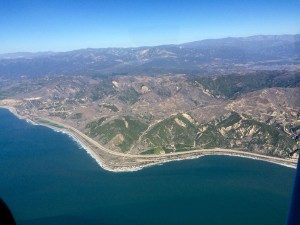
When we got close, Santa Barbara Approach handed us off to the tower and that was it – we were inside class C airspace! It was kind of anticlimactic. KSBA was less busy than KCMA (class D). The only difference was that tower was giving us vectors, which actually makes your life easier. We landed on runway 15L and taxied to the Atlantic FBO. One difference was that we were told to “monitor” the ground frequency, not to “switch” to it, which apparently means “switch frequencies but don’t self-announce.” Tower had already given us taxi instructions, so we didn’t need more info from ground, but we would certainly want to be listening if they had anything more to say to us (they didn’t).
We signed in at the FBO and then walked down to the beach! There is a nice 10-15 minute walk to Goleta Pier and a cafe right there. Perfect lunch spot!
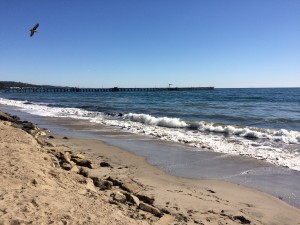
3. From KSBA to KSMO:
After lunch, I flew us back. A class C airport requires that you first call “clearance delivery” to make your departure request. The key pieces of information you need are summarized by the acronym “CRAFT”:
- C: Clearance (e.g., if it’s a named procedure, or your destination)
- R: Route (direction)
- A: Altitude
- F: Frequency (of departure control)
- T: Transponder (squawk code)
We were assigned runway 15L, the same one we’d landed on. Except that the winds were now from 320 at 3 kts. I stared at that for a minute before saying, “That’s a tailwind,” in puzzlement. Manuel noted that they don’t like you to take off to the north since there is a big mountain right there. So… okay… 3-kt tailwind… but more runway than we really need, so I guess that’s okay…
[Note: that uneasy feeling is a sign that you should probably check your personal minimums and decide whether you want to proceed. This is something I am still working on. Curiously, “tailwind component” is not on the list (only “crosswind component”).]
There was also a warning for “low-level wind shear”, which is NOT a pilot’s friend. As we taxied into position, I kept glancing at the wind sock, which was swinging around. Tower announced that the wind was now from 090 at 7 kts, which was stronger, but I’d rather have that crosswind than a tailwind.
While we waited, I heard another plane being cleared to take off on runway 7 (KSBA has crossing runways). That would be a much better runway, given the winds, but maybe they only use that one for commercial traffic. Anyway, we finally got cleared to take off and “maintain runway heading.”
This makes for a breathtaking soaring climb out over the ocean. We were initially told to stay at or below 1800′, but before we reached that altitude, they canceled the restriction. I kept the heading nailed, but after a while of climbing into the big blue sky I rather wanted to turn and head for Santa Monica (and get back closer to land). Tower kept us heading out for what seemed like a really long time (we got to about 5000′) before allowing us to turn.
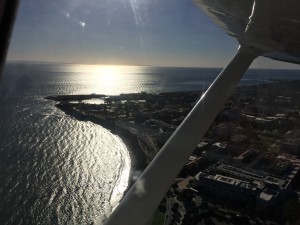
Since we hadn’t actually asked for “flight following”, I wondered how that would work out. We had a squawk code, but in some online discussions I’ve seen cases where towers assign local codes that aren’t valid once you leave that airspace. But tower handed us off to departure, and departure to Mugu, then SoCal approach, and a couple of times we got traffic warnings, so it all seemed to work perfectly.
That same wind that had sped us over to KSBA fought against us on the way back. I had trouble getting the plane up to 100 kts ground speed (despite 120 kts indicated).
Santa Monica beach and pier:
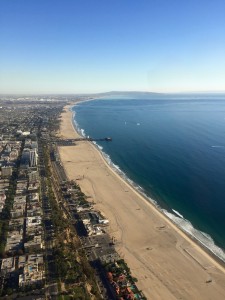
I got a right downwind approach to runway 21 at KSMO along with a request to “keep it tight” (someone else coming in). The approach and set-up were all fine, but at the last minute I tried to fix the sun visor (we were landing right into the sun and I don’t have sunglasses) and I think that threw me off a little – a bit of a clunk! Lesson learned: don’t mess with stuff when you’re 20 feet off the ground, even when it seems trivially easy 😃 (Yes, I already knew that. But sometimes experiencing it really shows you why!)
4. KSMO to KEMT:
After dropping Manuel off, I taxied up to take off of RW 21 for return to KEMT. I was #5 in line waiting! I got to watch a Decathlon take off (cute little tailwheel!). Then I was off and turning into a left downwind departure. Manuel got this great shot of my takeoff, including people on the observing deck.
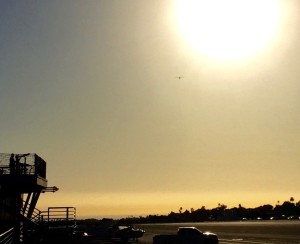
Despite my request, I never did get flight following set up by the KSMO folks, but it’s such a short flight that I just kept my eyes peeled, stayed under the Bravo, and switched over to KEMT when I was downtown. I got a nice normal right traffic entry to RW 19 and a very nice landing near sunset. Done!
 I am heading to the Cook Islands in a few weeks to explore the island of Rarotonga. This is a tiny island, covering 26 square miles and with a population of 10,000, in the south Pacific.
I am heading to the Cook Islands in a few weeks to explore the island of Rarotonga. This is a tiny island, covering 26 square miles and with a population of 10,000, in the south Pacific. 






